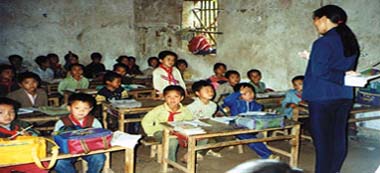|
China education Charity gives hope for students in China By Samantha Wong |
|
The education system in China has aroused the concerns of people in Hong Kong. The problems faced by poor regions especially has drawn their attention. Different organisations are now making efforts to improve China’s educational system. There are a number of problems in the present system. First, the dropout rate is high in the poorer regions. The southwestern and northwestern provinces of China, including Guangxi, Yunnan and Guizhou, are regarded as poor regions. In areas that are remote and mountainous, the natural |
Courtesy of World Vision International Women take opportunity to learn some new vocabulary. |
|
environment is not favourable for farming. Thus, the livelihood of the large peasant population is greatly affected. Mr. Clement Lam Ming Cheung, who is active in the China Development and Services Fund, explained the situation this way: “China now has a 9-year compulsory education programme. Students need not pay school fees, but they have to pay for their books and miscellaneous expenses. “However, in villages where poverty prevails, people cannot afford to let their children go to school. Children are required to undertake farm duties and household chores.” According to Mr. Lam, some areas also face a shortage of teachers. Said he: “Teachers trained in one area will be assigned to teach there, so if few teachers choose to be trained in one area, there will not be enough teachers. “Some teachers do not want to teach in rural areas because of the low salary,” said Mr. Lam. “Therefore a teacher may have to teach two classes at a time in some areas.” Besides, the quality of teachers is a problem. According to Educational Statistics Yearbook of China 1995, while the qualification rate of full-time teachers in primary schools is 88.9 percent, the rates of those who teach in junior secondary schools and senior secondary schools are 69.1 percent and 55.2 percent, respectively. The lack of schools and teaching facilities is another problem in remote mountainous areas. Mr. Stanley Lee Yat On, vice chairman of the Association for Promoting Education in China, said, “In those areas, the local governments give the priority to construction of infrastructure. So less money is spent on education.” Mr. Lam also said, “In some areas, there are not enough books, and not every student can have one of his own.” In order to help China improve its education system, charities in Hong Kong have initiated different plans. The Association for Promoting Education in China, an organisation composed of volunteers from different professions, organises visits to remote and mountainous regions. The association twice organised visits to Fengkai County, which is in Guangdong Province but adjacent to Guangxi. “During the visits,” said Mr. Lee, “we brought with us some stationery, dictionaries and blackboards. “However, our support is not only a matter of providing material possessions. We also want to show our concerns,” said he. “We hope that by introducing new things in our visits, the children there will become curious and begin to explore the outside world. We hope these visits will sow seeds for sustainable development of the area.” Moreover, the association subsidizes 20 students in Fengkai to help them continue their studies. The China Development and Services Fund also provides subsidies to poor students, gives teaching materials to schools in remote areas, and organizes visits to Guangxi and Guizhou. At the same time, the fund carries out projects that raise money for building schools and offer opportunities for teaching and cultural exchanges. Mr. Lam, who participates in the activities of the fund, said, “The school buildings in some areas in Guangdong and Guangxi are in a bad state of repair. The roof may collapse or rain may leak in. The fund helps them to repair or rebuild the schools.” The fund has helped in the construction and repair of schools in Guangdong, Guangxi and Yunnan. “Moreover, the fund supports the Association for International Teaching, Educational and Curriculum Exchange Limited. Teachers from abroad are organised to teach in China. This not only allows teaching exchanges, but also makes culture exchange possible.” |
Courtesy of World Vision International |
|
The worldwide charitable organisation, World Vision International, launched educational campaigns in China as well. Like the other two organisations, the China Office of World Vision International makes efforts in improving basic education in China. However, the focus of their concern is more specific. According to A Report on Education in China, which is published by the China Education Committee of the Hong Kong University Student Union, the enrolment and dropout rates of girls are higher than those of boys. World Vision also realizes the situation and so girls have become one of their main concerns. Miss Phoebe Lai Yuet Sim, senior communications officer of the China Office of World Vision International, explained their educational projects for girls. “We hold girl literacy classes and build schools for girls to encourage them to go to school,” said Miss Lai. “Moreover, when providing educational subsidies and scholarships, we give the priority to girls.” Girls of national minorities also benefit from World Vision projects. “National minorities mainly live in the poor regions,” said Miss Lai. “The enrolment rate of the girls is lower than that of boys. So we provide education to the girls there.” For instance, in Guyuan county in Ningxia, World Vision provides basic education to girls. At the same time, needlework and farming with technological means are taught in the schools, allowing the girls to make their own living in the future. Another focus of concern of World Vision is orphans. The educational needs of orphans in China are met through the Orphans’ Scholarship Project. Special education is provided by World Vision. “In Guangxi,” said Miss Lai, “we have a project for visually impaired children. Educational subsidies are provided. Teachers are trained to teach them.” Furthermore, World Vision helps students in disaster-affected areas resume classes as soon as possible by providing educational assistance, textbooks, and tents as temporary classrooms, and reconstructing schools. While many organizations concentrate their help on education for children, World Vision carries out projects on adult education as well. Said Miss Lai: “We noticed that the illiteracy rate of women is high in poor regions. Moreover, we find that people who are forced to drop out their studies due to poverty later become illiterate again. Thus, we hold literacy classes at night for adults. “In these classes, they are taught simple calculations so that they will not be cheated in trade. Knowledge and vocabulary related to agriculture and everyday life are also taught.” The assistance offered by different organizations in Hong Kong contributes to a rise in the number of children receiving primary school education. According to Educational Statistics Yearbook of China 1995, the net enrolment rate of school-age children has risen from 84.7 percent in 1965 to 98.5 percent in 1995, in spite of the relatively low promotion rates of junior and senior secondary school graduates. Although the work done by different organisations concerning education in China is different, their final aim is to help the people shed their life of poverty and eventually lead a better life relying on their own means. They all hope that their help will pave the way for the future development of China. |
 New immigrants
New immigrants
December 1997
[Editorial] [Letters] [Answer] [News] [Social] [Photo] [Culture] [Education] [Channels] [Science] [Celebrity]
Comments Editor-in-Chief Electronic Editor